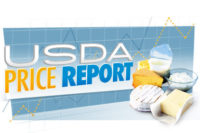It seems every year presents its own set of challenges and opportunities for the U.S. dairy sector. After what seemed to be never-ending milk and dairy ingredient price increases in 2013 and 2014, markets retreated in 2015.
That is, some markets retreated. Particularly, U.S. dairy product markets most exposed to global markets posted significant declines on the year.
With more than 50% of the annual U.S. nonfat dry milk (NDM) production of 2.3 billion pounds destined for foreign sales, U.S. NDM prices converged with ever-declining global NDM/SMP prices to maintain market share. Between peaking in March 2014 at $2.10 per pound and bottoming near 70 cents in August, U.S. NDM prices fell an astonishing 66% in less than 18 months.
Global and domestic NDM prices are showing signs of recovery, but prices above $1.25 per pound are not expected until the second half of 2016.
Nevertheless, in the dairy sector, it is always good to plan for the unexpected such as poor weather and profitability, which could reduce 2016 global milk output below 2015’s levels. At the same time, many global powder buyers that were priced-out of the market in 2013 and 2014 returned in 2015. These importers are likely to support NDM prices up to the $1.50 price level.
Lower milk costs this year
The exceptionally lower NDM prices translated into significantly lower 2015 milk costs for manufacturers of low-fat dairy products like yogurt and low-fat cottage cheese. Favorable skim pricing is likely to continue through mid-2016; however, it is prudent to plan for prices near the five-year average for the second half of the year.
The collapse in NDM prices weighed on the domestic cheese market but did not result in the level of price reduction experienced in Europe and Oceania. CME Group (CME) spot Cheddar cheese prices have traded within a narrow range.
Expect lower cheese prices
In recent weeks, at a time when seasonal demand typically buoys prices, the market has uncharacteristically experienced a downward price adjustment to near $1.60. Historically, the CME spot cheese market rises through September and into October ahead of strong holiday demand. This year, the seasonal price escalation is not expected to be as lofty.
Once again, the market may take a run at $1.75, but inventories are ample and milk continues to flow into cheese vats, especially east of the Rocky Mountains.
Domestic consumers have benefited from this year’s stable cheese prices. The August 2015 Consumer Price Index for cheese was 2.5% less than last year. The latest retail cheese sales for the past 52 weeks are running more than 2.8% above the prior year.
Looking ahead, 2015 CME spot cheese prices are unlikely to be as stable as the past year. The large gap between U.S. prices and global cheese prices for most of 2015 created a supply chain of imports that is expected to continue through early 2016. That gap has closed in recent weeks, which may temper imports in the second quarter and support cheese prices between $1.75 and $2 per pound later in the year.
Volatile butter prices
The CME spot butter market is the only segment of the U.S. dairy complex that did not receive the memo that milk and dairy product supplies are burdensome around the globe.
The CME spot butter market requires USDA grading certificates with delivery. In contrast, the CME spot cheese market only requires that product meet grading criteria. As a result, there is less tradable butter in an already thinly traded market. Until the trading rule is changed, the CME spot butter market is expected to remain highly volatile. Next year, Easter lands on March 27. CME spot butter prices are expected to be higher than average during first-quarter 2016 because manufacturers have limited time to build stocks for the Easter drawdown. However, butterfat end-users are likely to get some price relief after the Easter buy-in is completed and prior to the start of ice cream season.


